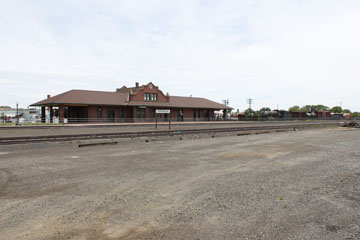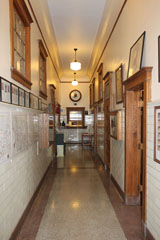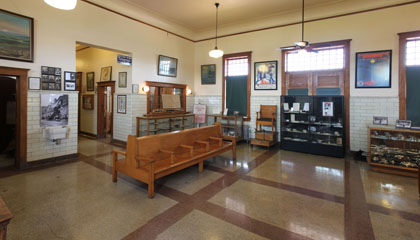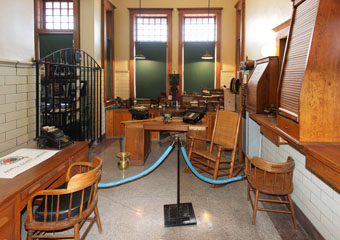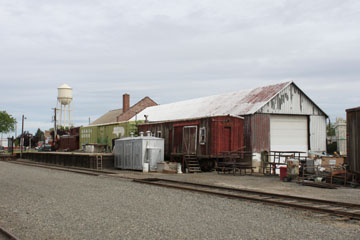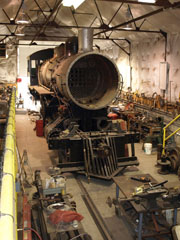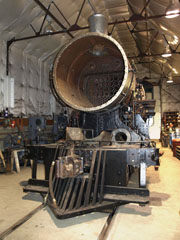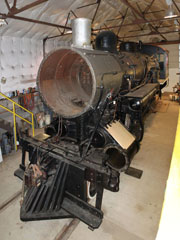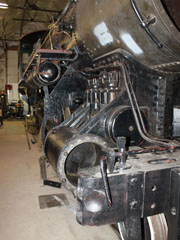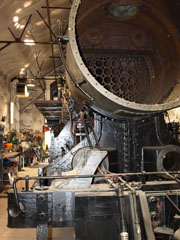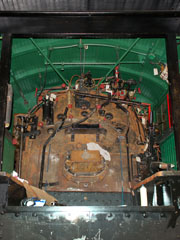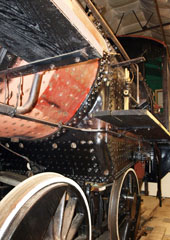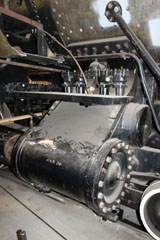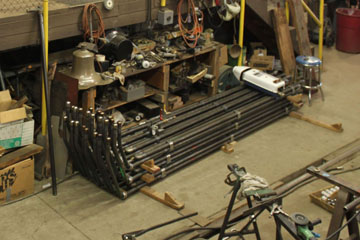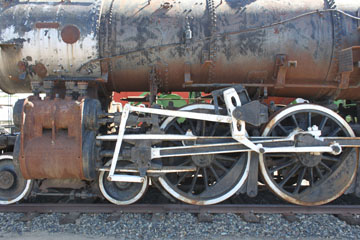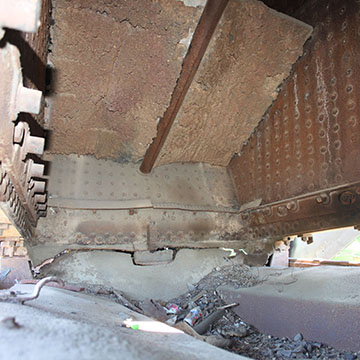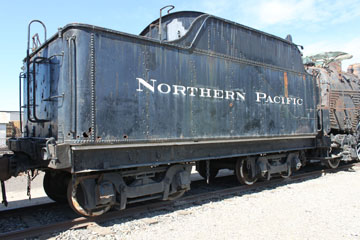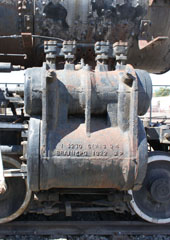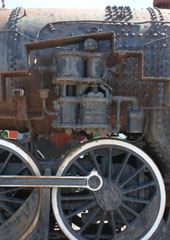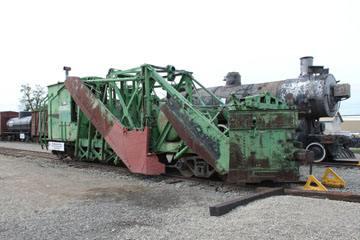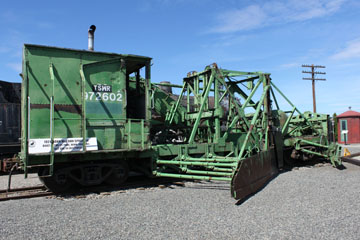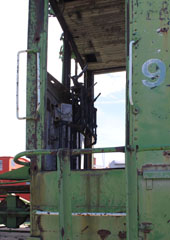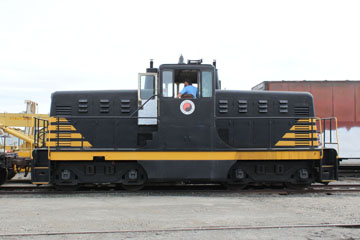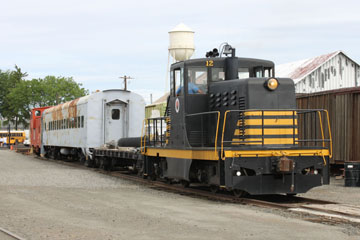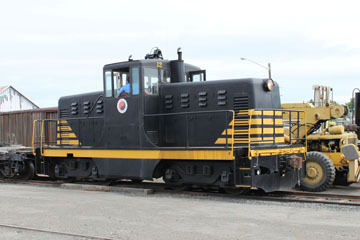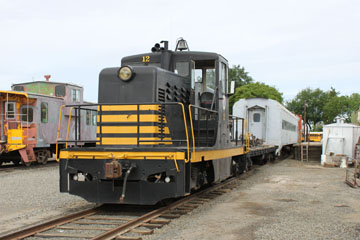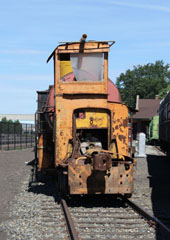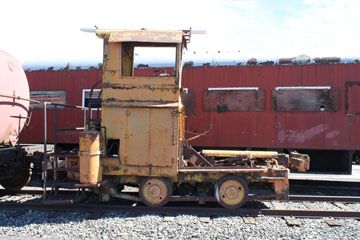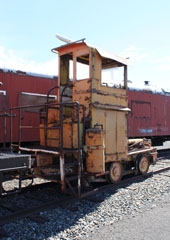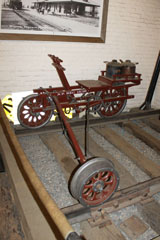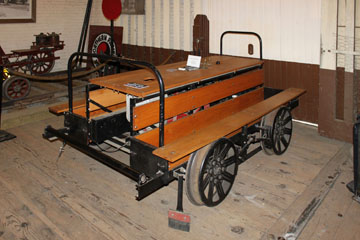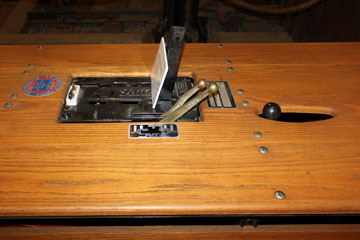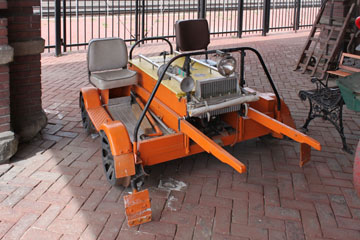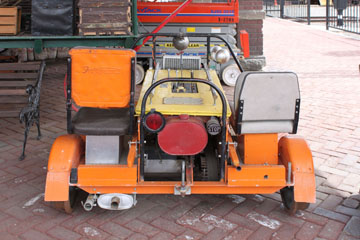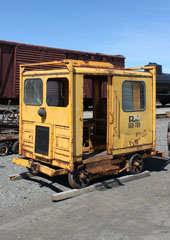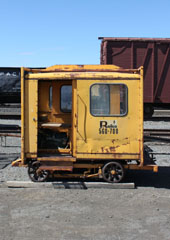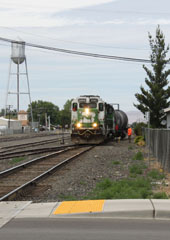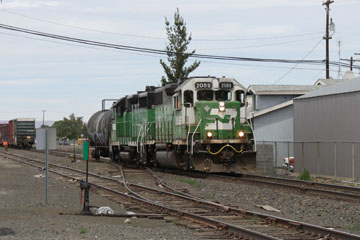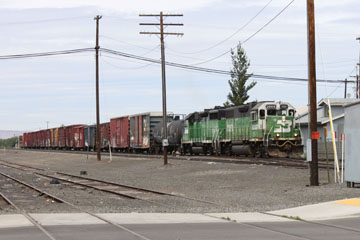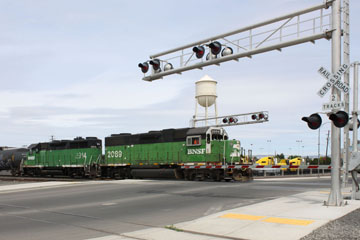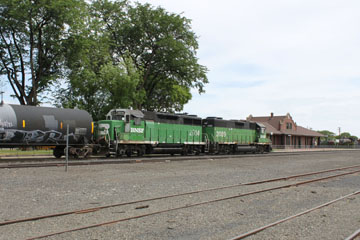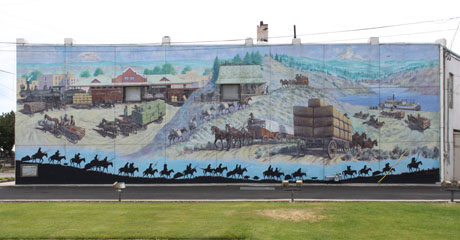

The Northern Pacific Railway Museum is located in Toppenish, WA, at the junction of Asotin Ave and Status Ave. It is on the site of what was once the Northern Pacific Railway yard, with the office, gift shop and many static displays inside the depot building. It is operated by the Yakima Valley Rail and Steam Museum Association.
During the Northern Pacific Railway Museum Rail Show held annually in late August, the Tri City Model Railroaders set up a large HO-gauge model railway for public viewing in the depot building, and there is also a model display called "Toy Train Christmas" in December. On weekends when the museum is open, there are yard rides, which include the obligatory “Easter Bunny” and “Polar Express”. The museum also provides engineer and brakemen training and, every few months, runs work/history weekends in partnership with the Northern Pacific Railway Historical Society.
I have visited the museum several times, and have always been made to feel very welcome! The photos on this page are from various visits.



The Northern Pacific line from St Paul, MN, arrived in 1884, although the final link with Tacoma on the Pacific Coast was not finished until completion of Stampede Tunnel through the Cascade Mountains in 1886. The first allotments were platted here in 1905 by a woman of half Native American ancestry, Josephine Bowser Lillie, known as “The Mother of Toppenish”.
The township was incorporated in 1907 and continued to grow as Anglo-American settlers sought to capitalise on the rich bounty of the Yakima River Valley.
The depot building was constructed in 1911, with a nod to the Mission Revival style, while incorporating a typically Northern Pacific utilitarianism. At its height, the depot saw four local passenger trains, and the Northern Pacific’s flagship North Coast Limited stopped briefly twice each day to pick up or drop off passengers.
A branch line, started by the Toppenish, Simcoe, & Western Railroad in 1909, was completed five years later after being taken over by the Northern Pacific. It ran nineteen miles west from Toppenish to White Swan.
The museum officially opened on 4th July 1992 and, the following year, the depot building and adjacent freight house were bought from the Burlington Northern. Today, the depot building is much as it would have appeared during the first half of the 20th Century. Recent work has
included rebuilding a set of roof-top dormer windows
Below, the old freight house has been converted to an engine house. The corrugated iron addition shown in the lower photo houses NP S-4 #1361, which is being restored.
Freight items were mainly agricultural: wheat, livestock, sugar beets, potatoes and some varieties of soft fruit but, particularly hay, which became one of the largest commodities shipped from Toppenish during WWI (it fed the many horses deployed in the theatre of war).
Traffic boomed again during WWII but, during the 1950s, it began an inexorable decline.
The lease was
granted in 1990 and many hours of volunteer work followed to restore the interior.
On display are a huge range of NP-related artefacts including, above, a passenger wheelchair and below an NP feather duster!
As automobile, bus and airplane services increased, railroad transportation lost out, and passenger service from the depot ceased in 1961. By 1981, it was no longer in use and was boarded up.
In 1989, a group of railfans approached the city and NP’s successor, the Burlington Northern, to lease the depot as a railroad museum.

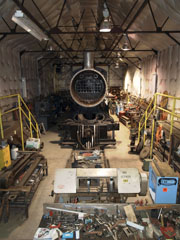
S-4 #1364 was one of forty Vauclain compound Ten Wheeler (4-6-0) type locomotives built for
the Northern Pacific Railroad in 1902 by Baldwin (#1350-#1379). They brought the railroad’s roster of Ten Wheelers to two hundred and fifteen.
As built, #1364 had
15½” x 20” high
pressure and 26” x 30” low pressure cylinders, a 50.74 sq ft grate, a 200
sq ft firebox with 28.46 sq ft of arch tubes and a total heating surface of 3,092 sq ft. It weighed 190,450 lbs, 148,300 lbs on its 63” drivers. Operating at a boiler pressure of 200 psi, it delivered 28,698 lbs tractive effort.
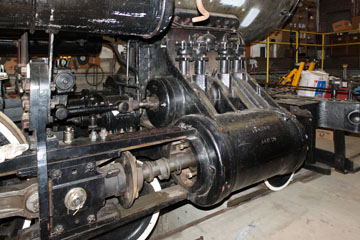
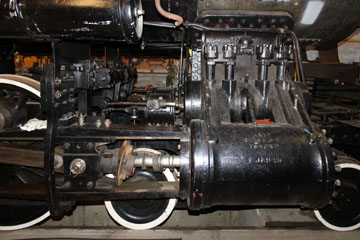
As with so many US railroads, the Northern Pacific found the added maintenance costs of Vauclain compounds offset savings in fuel and water, and the S-4 Class was progressively simpled after WWI and fitted with superheating.
The rebuild reduced the grate to 49.7 sq ft and the firebox to 155 sq ft. Total heating surface was then 2,732 sq ft, including 485 sq ft superheating, and the weight dropped to 184,850 lbs. An increase to 146,000 lbs on the drivers, however, combined with superheating, increased tractive effort by 20% to 35,700 lbs.
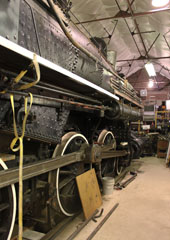
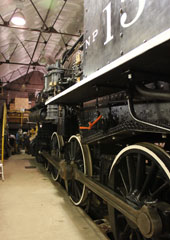
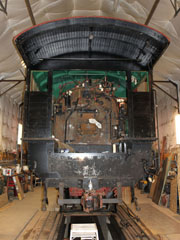
Above, note the extra distance between the middle and rear drivers, which gave a little more room for the firebox. The S-4 was popular with crews and performed well. They were originally mountain-based passenger haulers but, with the arrival of larger power, were moved to branchline work, local freight and local passenger service and, occasionally, worked as pushers.
Below, the Westinghouse dual air pump was installed between my visits, as well as the main rods. The internal Stephenson valve gear was retained when #1364 was simpled.
#1364 retired in 1954 and was donated to the City of Tacoma, WA.
Following an aborted attempt at restoration in 1975, it then came very near to being scrapped.
The museum acquired a lease on the locomotive in 1993 and moved it to Toppenish the following year.
When I last visited, the restoration was nearing completion.
Right and below, jacketing had been fitted to both sets of cylinders and, bottom, the superheater tubes were ready to be installed. These had been constructed by museum volunteers.


Passenger service was growing on the Northern Pacific during the early 1900s, leading to greater demand for motive power. The Q-1 Class Pacific (4-6-2) type locomotives built by Alco had already proven themselves, and the additions to the roster were based on the Q-1, although the twenty-three new Q-3 Class (#2148-#2170) were ordered from Baldwin in 1909, probably because of more competitive pricing.
The Q-1 was the last NP locomotive built with Stephenson inside valve gear. The Q-3 and all subsequent engines had Walschaert valve gear.
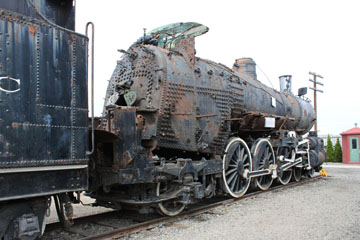
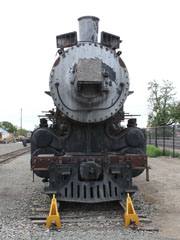
The Q-3s started work primarily on the Lake Superior and St. Paul Divisions, although two went west to haul the North Coast Limited between Livingston and Butte, MT, assisted by helpers over Bozeman Hill and through Homestake Tunnel.
Other Q-3s also went west over time, usually as a result of being demoted to branch line or local service.
By 1929, all twenty-three Q-3s had been bumped from main line
passenger assignments following the arrival of heavier power in the form of Q-5 and Q-6 Class Pacifics and Class A Northerns.
As built, #2152 weighed 236,000 lbs, 150,000 lbs on its 69” drivers. With 22” x 26” cylinders, a 242 sq ft grate, 43.5 sq ft firebox, including an 8 sq ft arch tube and total heating surface of 2,926 sq ft, it operated at a boiler pressure of 200 psi delivering 31,004 lbs tractive effort.
Between 1914 and 1921, all the Q-3s were superheated. Although the engine weight remained the same, weight on the drivers was reduced to 146,200 lbs. The grate was reduced by 1 sq ft, and total heating surface increased to 3,064 sq ft including 444 sq ft superheating.
In 1922, #2152 was rebuilt with 23” x 26”
cylinders. In 1932, it was assigned as a head-end helper on the Yellowstone Division. While working there, to comply with union agreements on manning, #2152 had been fitted with a Duplex Stoker, but this was removed in 1941 as the new A Class 4-8-4s assigned to the Division no longer needed helpers.
By 1949, two Q-3s had been scrapped and the roster started to dwindle from then, although several worked on between Duluth, and Dilworth, MN, until late 1954.
Above, the tender weighs 141,350 lbs light and has a 7,000 gallon water and 12 tons coal capacity. The NP initially considered using round tenders for the Q-3s but this idea was abandoned because of concerns about leaks.
Retired in 1958, #2152 was donated to the City of Auburn, WA, and placed on display in a city park. During the next five decades its condition progressively deteriorated, and Auburn sought to dispose of it. The engine was bought by the museum in 2006 and restoration work will start as soon as #1364 is complete.

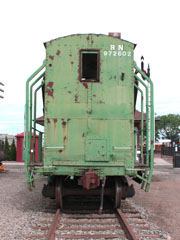
This is the sole surviving Mann McCann ballast spreader, one of five bought from its builder, the St. Paul Foundry Company, by the Northern Pacific in 1921 (#641-#645).
Nothing appears to be known about the fate of #641, but #644 was bought by the Spokane, Portland & Seattle Railway in 1945 and was scrapped in 1954.
The Burlington Northern acquired #642, #643 and #645 with the Northern Pacific merger in 1970, and the spreaders were later renumbered #972602, #972603 and #972604 some time in the years between 1974 and 1977.
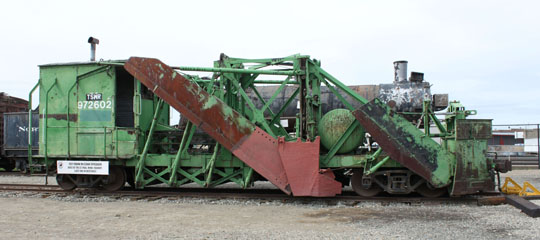

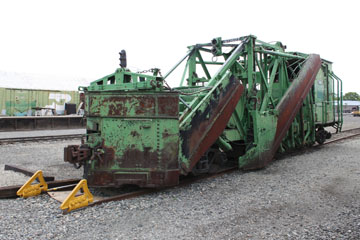
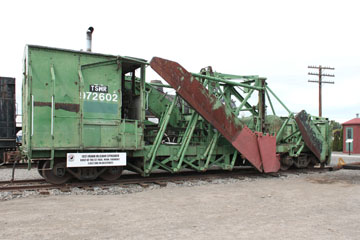
Spreaders were used during summer to push ballast back up onto the roadbed and during winter to plow snow from tracks. Snow was pushed from one track of a double track line, then a rotary snowplow would throw the snow off the second track.
#642 was used on Stampede Pass until about 1985. After retiring, it sat unused on a spur track just off Meade Avenue in Yakima, WA. In 1996, it was bought by the museum for $1,000, and was shipped to Toppenish at no charge by the Washington Central Railroad.
Above and left, #642 with its wings open. Below, the controls.
You can see more spreaders on the Nevada Northern Railroad, Baltimore & Ohio Railroad Museum Yard and Car Shed, and the South East Railroad Musem pages of this website.


#12 is a 65 ton centre-
cab diesel-electric switcher built by General Electric in 1943. The museum uses it to haul passenger trains along a very short section of track across the old freight yard.
#12 has two 235
Cummins diesel engines delivering 400 hp. With 39,000 lbs starting tractive effort at 30% adhesion and 12,000 lbs continuous tractive effort at 10 mph, it has a top speed of 40 mph.
GE built only one hundred and fifty of the 65 ton switcher for the US market. Another thirty-three went to Canada and other overseas countries.

Toppenish prides itself on its colourful murals, which are dotted about the central business area and added to regularly. They commemorate the history of the city and surrounding area. When I last visited, there were seventy-three, four of them featuring some aspect of the railroad.
Top, “NP Railroad: Across the Valley” on the north side of the old freight house on Asotin Ave shows construction of the railroad through the Yakima River Valley.
Centre left, “Crossroads to Market”, in Old Timers Plaza on S Toppenish Ave just opposite the depot
building, shows the different means of getting agricultural produce to market in the valley during the early 19th Century.
Centre right, “All Aboard” on Buena Way depicts a passenger train standing at Toppenish depot in the 1930s. A rather odd looking #1364 waits next to it at the head of a freight train.
Bottom, the design of this mural is in the form of a woven blanket worn by Hispanics as a cloak or poncho, which gives the mural its name, “El Sarape”. It tells the story of the braceros, workers who came to the area from Mexico to help harvest crops while many of the local Anglo-American men were overseas in WWII. Another slightly fanciful depiction of #1364 appears.






